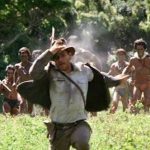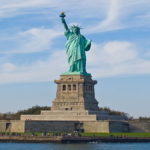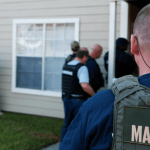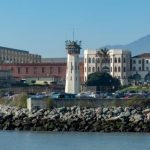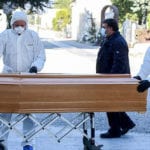 Mysteries
Mysteries  Mysteries
Mysteries  History
History 10 Surprising Stories About the Texas Rangers
 Humans
Humans 10 Philosophers Who Were Driven Mad by Their Own Theories
 Miscellaneous
Miscellaneous 10 Video-Game-Worthy Weapons and Armors from History
 Weird Stuff
Weird Stuff 10 Psychics Who Accurately Predicted Wartime Events
 The Arts
The Arts 10 Pieces of Art Inspired by a Broken Heart
 Health
Health 10 Science Fiction-Sounding New Medical Treatments
 History
History 10 Surprising Facts About the Father of Submarine Warfare
 Space
Space Ten Astonishing New Insights into Alien Worlds
 Weird Stuff
Weird Stuff 10 Bizarre Summer Solstice Rituals Still Practiced Today
 Mysteries
Mysteries Top 10 Haunting Facts About the Ghost Ship MV Alta
 History
History 10 Surprising Stories About the Texas Rangers
 Humans
Humans 10 Philosophers Who Were Driven Mad by Their Own Theories
Who's Behind Listverse?

Jamie Frater
Head Editor
Jamie founded Listverse due to an insatiable desire to share fascinating, obscure, and bizarre facts. He has been a guest speaker on numerous national radio and television stations and is a five time published author.
More About Us Miscellaneous
Miscellaneous 10 Video-Game-Worthy Weapons and Armors from History
 Weird Stuff
Weird Stuff 10 Psychics Who Accurately Predicted Wartime Events
 The Arts
The Arts 10 Pieces of Art Inspired by a Broken Heart
 Health
Health 10 Science Fiction-Sounding New Medical Treatments
 History
History 10 Surprising Facts About the Father of Submarine Warfare
 Space
Space Ten Astonishing New Insights into Alien Worlds
 Weird Stuff
Weird Stuff 10 Bizarre Summer Solstice Rituals Still Practiced Today
Ten Tales from Dallas’s Parkland Hospital, Where JFK Died
By now, even casual history buffs are familiar with Dallas’s Dealey Plaza on the afternoon of November 23, 1963. JFK next to Jackie in the limo, the governor of Texas in front of him. Abraham Zapruder filming from atop a cement partition near the grassy knoll, Orville Nix recording from the opposite perspective. And, of course, Oswald perched at a sixth-floor window, overlooking it all.
However, fewer folks know the harrowing, often gory details of what transpired immediately afterward. Here are ten tales from Parkland Hospital, President John F. Kennedy’s next—and final—stop that terrible day.
Related: 10 Pieces Of Evidence Pointing To Oswald As JFK’s Killer
10 Jackie Wouldn’t Let Them Take JFK Inside
Clint Hill, the Secret Service agent who famously splayed himself over JFK and the First Lady seconds after the shooting, knew the president was dead. As the limo floored it toward Parkland, Hill flashed a thumbs-down signal to the agents in the follow-up car, indicating how grave the situation was.
Still, that didn’t mean they weren’t going to try. Except that when they pulled into the Parkland receiving area exactly eight minutes after the shooting…Jackie Kennedy wouldn’t let her husband go.
Hill recalls the urgent stalemate: “I asked Mrs. Kennedy, I said, ‘Please let us help the president.’ No response. She had ahold of him, and she wouldn’t let go. So I pleaded with her again and still no response.”
It’s well documented that, in the weeks after JFK’s death, Jackie became a protector of her slain husband’s Camelot legacy. In fact, this role began then and there. From the gaping head wound—a good portion of the brain had been blown out—Jackie Kennedy knew JFK was either unsavable or already dead.
She was simply not going to let the media capture the extent of this gore on camera. Hill continues:
“I realized the problem was she didn’t want anybody to see the condition he was in because it was horrible. So I took off my suit coat, I covered up his head, his upper back. As soon as I did that, she let go.”[1]
9 Matter of Life & Death
Immediately following the fatal headshot at Dealey Plaza, Jackie Kennedy can be seen climbing out of her seat and onto the trunk of the convertible. Horrifyingly, she was retrieving a large piece of her husband’s brain and skull.
She was able to collect the fragment before Secret Service agent Clint Hill hopped aboard and dove on her and JFK, a human shield. As her husband’s head rested in her lap, the First Lady collected additional chunks of tissue from the limousine seat and floor.
Arriving at Parkland, Dr. Marion Jenkins was fighting in vain to save JFK’s life in Trauma Room One when a traumatized Jackie did her best to help: she handed him all the brain and skull matter she’d managed to salvage. Forty-five years later, Jenkins’ daughter shared a recorded exchange she had with her father before his death. “My father began manually squeezing oxygen into [JFK’s] lungs and administering resuscitative drugs,” the daughter, Christie Jenkins, recounts.
“Kennedy’s blood was dripping down my dad’s trousers and into his shoes. The team realized the head wound was so massive the president just couldn’t survive.” That was the moment Jackie poked him in the elbow, leaned forward, and hopefully, handed him the remnants of his head she’d collected. [2]
8 A Sobering Faux Pas
Upon entering Parkland, anyone who took one look at the president’s condition knew he was either already dead or unsavable. Given his gaping head wound and motionless body, it didn’t take a doctor or even a nurse to see that JFK was gone.
Still, this was the President of the United States—plus, his wife was at his side. So the surgeons at Parkland were going to treat JFK as if he were savable and hope for a miracle. Among other emergency measures, Dr. Charles Baxter was administering closed-chest cardiac compressions in an attempt to restore some semblance of a normal heartbeat.
Then another doctor, neurosurgeon William Kemp Clark, burst into the trauma room. According to Joe Goldstrich, who as a 25-year-old medical student was the youngest staffer to tend to the president, Clark saw Baxter’s futile effort and exclaimed, “My God, Charlie, what are you doing? His brains are on the floor.”
Clark hadn’t, of course, seen Jackie before he blurted out the macabre faux pas. No one—doctor, nurse, or the First Lady herself—could pretend any longer that what they were doing had any hope of saving JFK’s life.
“When he did see her, I was right between them,” Goldstrich recalls. “I saw her expression when she heard what he had said. That’s another moment that’s indelibly imprinted on my brain.”[3]
7 A Troubling Tracheotomy
Then as now, it is common for someone in as grave a situation as the president to have a tracheal tube inserted for easier breathing or administering certain medicines. At Parkland that day, this decision was made all the more obvious given that a bullet had passed directly through Kennedy’s neck—a wound suffered prior to the fatal headshot.
Coincidentally, Joe Goldstrich—the same young medical student who recalls the look on the First Lady’s face when one doctor admonished another’s hopeless heart massages—had been studying up on tracheotomies just that morning. In the same 2020 interview from the previous entry, he remembers seeing JFK’s neck wound and thinking he could be intubated right through the wound—no cutting necessary.
But other doctors—all his seniors—apparently thought otherwise and cut over the wound at the front of JFK’s neck before inserting the tube. Goldstrich said not speaking up was his only regret about the medical care Kennedy received that day.
This is because cutting over the wound wasn’t just unnecessary—it destroyed evidence. By eliminating the original shape of the wound, doctors made it impossible for autopsy specialists to determine whether it was an entrance or exit wound. And, therefore, whether the bullet’s likely origin was from behind (the Texas School Book Depository, where Oswald worked) or the front (the now-infamous grassy knoll).[4]
6 Cold Calls: Pranking Parkland
Photo credit: Wikimedia Commons
Initial news of the shooting, including early reports that the president may have been struck in the head, prompted well-wishers across the country. Unfortunately, it also brought out the creeps and crazies.
According to historian William Manchester, as surgeons tried desperately to resuscitate the president in the operating room, something else entirely was going on in the operator room. There, the telephone switchboard was alight with incoming calls.
Unfortunately, while some of the calls were legit, most were not. This is because the calls from genuine insiders—for example, Ethel Kennedy, JFK’s sister-in-law—were patched straight to the Army Signal Corps. So the majority of the direct-dial, long-distance calls came from, as Manchester writes, “the curious, the disturbed, the downright demented.”
He continues: “A woman in Toledo identified herself as ‘The Underground’; she asserted that she had occult powers which would keep Kennedy alive. A man said, ‘You n****r lovers, you killed our president.’ Another man threatened an operator: ‘I know who you are, and you’d better be careful when you start your car.’”
“Most disquieting,” again per Manchester, “was a young boy who called three times, talking to a different operator each time. His approach never varied. ‘I want to talk to my Daddy,’ he would begin plaintively. Asked who his father was, he would say, ‘My Daddy—President Kennedy.’ Then he would giggle and ring off.”[5]
5 “If Thou Livest…”
Since JFK was Catholic, a priest was summoned to perform the church’s Last Rites. With updates on Kennedy’s status limited, the news circulated on broadcasts—along with reassurances that this didn’t necessarily mean he was near death. Better safe than eternally sorry.
Soon, local parish priest Father Oscar Huber arrived at Parkland and was led into the trauma room. The president was already covered in a white sheet, with only his feet exposed. He was motionless.
“I did not speak to him,” Huber wrote later because “it was evident he could not answer.” Huber pulled down the sheet below JFK’s nose. Seeing the fixed eyes and gaping head wound, Huber became “sure that he was dead.”
Still, the idea that he would refuse to perform the Last Rites on a just-deceased, assassinated president was unfathomable. So Huber opened his ritual book, anointed the president’s bloody forehead with holy oil, and began his blessing: “If thou livest…”
Concluding the rite, he comforted Jackie and assured her that her husband’s spirit had not yet left his body. In a televised interview a few days later, Huber confirmed that the sacrament was given “conditionally because we didn’t know whether he was living or dead.”
Outside—and despite Secret Service warnings to keep quiet—Huber became among the first unofficial sources to reveal that JFK had indeed died. Though Huber denied it afterward, Time Magazine’s Hugh Sidey reported Huber responding “He’s dead all right” to an inquiry about the president’s condition.[6]
4 “Mr. President…”
Lyndon Baines Johnson, who described the vice presidency as not being worth “a bucket of warm piss,” was two cars behind JFK. He was with his wife, Lady Bird, and Texas Senator Ralph Yarborough. Despite initial reports that Johnson was either wounded or suffered a heart attack, he was unharmed.
Arriving at Parkland, agents yanked LBJ to his feet and hurried him inside. They settled in a windowless room removed from the trauma ward. There, LBJ, Secret Service agent Thomas Johns, and JFK aide Kenneth O’Donnell discussed an exit strategy should the worst come to pass. “Quick plans were made about how to get to the car, who’ll ride in what,” Lady Bird recalled.
Then, Assistant Press Secretary Malcolm Kilduff came into the room. “Mr. President…” he began. Johnson’s head jerked. Kilduff was asking permission to announce JFK’s death to the media.
Despite getting the official word of his impromptu promotion in the most macabre manner possible, Kilduff claims Johnson reacted immediately. “No,” LBJ said, “I think I had better get out of here and get back to the plane before you announce it. We don’t know whether this is a worldwide conspiracy, whether they are after me as well.”
Just before Kilduff’s announcement, LBJ left Parkland for Love Field Airport, where Air Force One awaited. Lady Bird saw flags atop the hospital drop to half-mast as they sped away.[7]
3 “This Is MY Body…”
Following the official announcement of the president’s death, JFK’s security detail placed his body in a coffin and began transporting it down the hall. There, they ran straight into local officials, including Dallas County Coroner Earl Rose. What ensued was among the stupidest “federal vs. local authority” standoffs in history.
Confronting JFK’s detail—some of whom had the president’s blood smeared on them—Rose had the audacity to insist that, per local law, an autopsy needed to be performed before the president could leave the premises. When Kennedy’s people refused, Rose reportedly exclaimed: “This is MY body.” Earl was, in part, capitalizing on an oversight: There was no law saying that murdering the president was a federal crime (in reaction to this incident, Congress rectified this in late 1963).
The Secret Service pushed past the local lawmen and proceeded, with JFK’s casket, to Dallas Love Field and Air Force One.
When the House Select Committee on Assassinations reopened the case in the late 1970s, Rose testified that Texas law made it the responsibility of the justice of the peace to determine the cause of death. Here’s a hint, Earl: He was shot in the head in front of dozens of witnesses.
The posthumous power struggle was portrayed in the 2013 film Parkland, which among other A-listers stars Paul Giamatti as amateur filmmaker Abraham Zapruder.[8]
2 Irony of Ironies
Two days later, accused assassin Lee Harvey Oswald was being led through the basement of the Dallas police headquarters. It was a routine transfer from the city jail to the county one.
Of course, nothing is routine when you’re handling the suspected murderer of the president. And with Dallas police already sensitive about their city’s hostile portrayal in the press, they took pains to accommodate TV crews and newspaper cameramen hoping for a shot of the killer in cuffs.
Too accommodating. Out popped local nightclub owner Jack Ruby who, for reasons still unexplained, shot Oswald in the abdomen at point-blank range. It was the first murder ever committed on live television.
The paddy wagon moved, and an ambulance was brought in. Oswald was whisked away to…where else? Parkland Hospital. In fact, one of the surgeons who treated him, Dr. Malcom Parry, had also tended to the president.
While Perry and his team were obligated by their Hippocratic Oath to treat Oswald as best they could, they sure as hell weren’t doing it in the same room as Kennedy. Oswald was intentionally taken to Operating Room #5 instead.[9]
1 Oddest. Memo. Ever.

Photo credit: Wikimedia Commons
On November 27—five days after JFK’s death, three after Oswald’s—Parkland Hospital Administrator Charles Jack “CJ” Price sent one of the weirdest thank you letters in the history of office memorandums. While well-intending, the note to all hospital employees reads like redundant, macabre overkill—like an executive grandstanding on paper when an in-person assembly would have sufficed. The note begged to be leaked, and leaked it was.
Its first two paragraphs are a cold, just-the-facts review of the previous week’s events. “At 12:38 pm, Friday, November 22, 1963, President John F. Kennedy and Texas Governor John Connally were brought to the Emergency Room of Parkland Memorial Hospital after being struck down by the bullets of an assassin.” The next paragraph gives the same weight to Oswald’s death. Captain Obvious, meet Administrator Tone Deaf.
Like something out of a tour brochure, the memo then embarks on a numbered list detailing the history that had occurred there. Price recounts that Parkland had:
1) Become the temporary seat of government of the United States
2) Become the temporary seat of government of the State of Texas
3) Become the site of the death of the 35th President
4) Become the site of the ascendency of the 36th President
…and so on. A few sentences congratulating everyone on their composure and professionalism, and the poor-taste pep talk ends with a signature and—just so reporters get it right, no doubt—Price’s printed-out name and title.[10]
